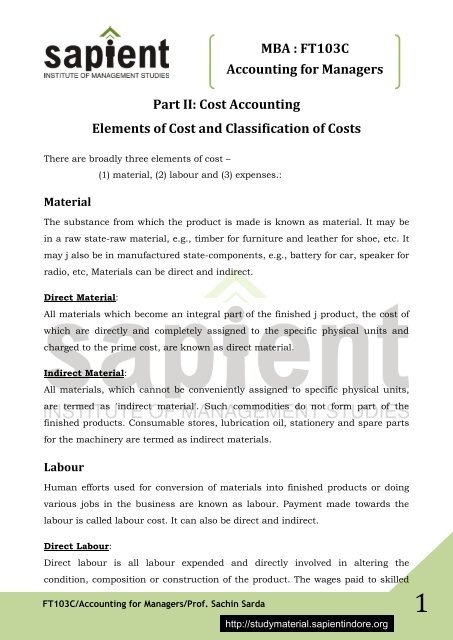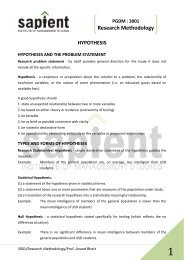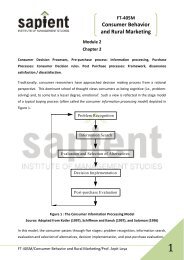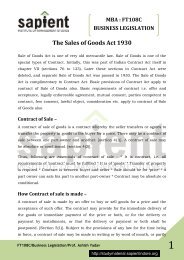Cost Accounting Elements of Cost and Classification of Costs
Cost Accounting Elements of Cost and Classification of Costs
Cost Accounting Elements of Cost and Classification of Costs
You also want an ePaper? Increase the reach of your titles
YUMPU automatically turns print PDFs into web optimized ePapers that Google loves.
MBA : FT103C<br />
<strong>Accounting</strong> for Managers<br />
Part II: <strong>Cost</strong> <strong>Accounting</strong><br />
<strong>Elements</strong> <strong>of</strong> <strong>Cost</strong> <strong>and</strong> <strong>Classification</strong> <strong>of</strong> <strong>Cost</strong>s<br />
There are broadly three elements <strong>of</strong> cost –<br />
(1) material, (2) labour <strong>and</strong> (3) expenses.:<br />
Material<br />
The substance from which the product is made is known as material. It may be<br />
in a raw state-raw material, e.g., timber for furniture <strong>and</strong> leather for shoe, etc. It<br />
may j also be in manufactured state-components, e.g., battery for car, speaker for<br />
radio, etc, Materials can be direct <strong>and</strong> indirect.<br />
Direct Material:<br />
All materials which become an integral part <strong>of</strong> the finished j product, the cost <strong>of</strong><br />
which are directly <strong>and</strong> completely assigned to the specific physical units <strong>and</strong><br />
charged to the prime cost, are known as direct material.<br />
Indirect Material:<br />
All materials, which cannot be conveniently assigned to specific physical units,<br />
are termed as 'indirect material'. Such commodities do not form part <strong>of</strong> the<br />
finished products. Consumable stores, lubrication oil, stationery <strong>and</strong> spare parts<br />
for the machinery are termed as indirect materials.<br />
Labour<br />
Human efforts used for conversion <strong>of</strong> materials into finished products or doing<br />
various jobs in the business are known as labour. Payment made towards the<br />
labour is called labour cost. It can also be direct <strong>and</strong> indirect.<br />
Direct Labour:<br />
Direct labour is all labour expended <strong>and</strong> directly involved in altering the<br />
condition, composition or construction <strong>of</strong> the product. The wages paid to skilled<br />
FT103C/<strong>Accounting</strong> for Managers/Pr<strong>of</strong>. Sachin Sarda<br />
http://studymaterial.sapientindore.org c<br />
1
MBA : FT103C<br />
<strong>Accounting</strong> for Managers<br />
<strong>and</strong> unskilled workers for manual work or mechanical work for operating<br />
machinery, which can be specifically allocated to a particular unit <strong>of</strong> production,<br />
is known as direct wages or direct labour cost. Hence, 'direct wage' may be<br />
defined as the measure <strong>of</strong> direct labour in terms <strong>of</strong> money.<br />
Indirect Labour:<br />
Labour employed to perform work incidental to production <strong>of</strong> goods or those<br />
engaged for <strong>of</strong>fice work, selling <strong>and</strong> distribution activities are known as 'indirect<br />
labour'. The wages paid to such workers are known as 'indirect wages' or indirect<br />
labour cost.<br />
Example: Salary paid to the driver <strong>of</strong> the delivery van used for distribution <strong>of</strong> the<br />
product.<br />
Expenses<br />
All expenditures other than material <strong>and</strong> labour incurred for manufacturing a<br />
product or rendering service are termed as 'expenses'. Expenses may be direct or<br />
indirect.<br />
Direct Expenses:<br />
Expenses which are specifically incurred <strong>and</strong> can be directly <strong>and</strong> wholly allocated<br />
to a particular product, job or service are termed as 'direct expenses'. Examples<br />
<strong>of</strong> such expense are: hire charges <strong>of</strong> special machinery hired for the fob, carriage<br />
inward, royalty, cost <strong>of</strong> special <strong>and</strong> specific drawings, etc. These are also known<br />
as 'chargeable expenses'.<br />
Indirect Expenses:<br />
All expenses excluding indirect material <strong>and</strong> indirect labour, which cannot be<br />
directly <strong>and</strong> wholly attributed to a particular product, job or service, are termed<br />
as 'indirect expenses'. Some examples <strong>of</strong> such expenses are: repairs to<br />
machinery, insurance, lighting <strong>and</strong> rent <strong>of</strong> the buildings.<br />
FT103C/<strong>Accounting</strong> for Managers/Pr<strong>of</strong>. Sachin Sarda<br />
http://studymaterial.sapientindore.org c<br />
2
MBA : FT103C<br />
<strong>Accounting</strong> for Managers<br />
Unit <strong>Cost</strong>:<br />
The cost incurred by a company to produce, store <strong>and</strong> sell one unit <strong>of</strong> a<br />
particular product. Unit costs include all fixed costs (i.e. plant <strong>and</strong> equipment)<br />
<strong>and</strong> all variable costs (labor, materials, etc.) involved in production.<br />
Batch <strong>Cost</strong>:<br />
Batch costing is used for calculating total cost <strong>of</strong> each batch. Batch is small<br />
group <strong>of</strong> units which is produced for production purposes. We also identify batch<br />
<strong>of</strong> units in our production. All raw materials is supplied on batch basis <strong>and</strong> other<br />
expenses are also paid on the basis <strong>of</strong> each batch.<br />
Job order cost:<br />
The job order cost system is used when products are made based on specific<br />
customer orders. Each product produced is considered a job. <strong>Cost</strong>s are tracked<br />
by job. Services rendered can also be considered a job.<br />
Contract <strong>Cost</strong>:<br />
Contract costing is a type <strong>of</strong> job costing <strong>and</strong> it applies to<br />
Civil construction works like: building contractors, dam, roads,<br />
Civil Engineering firms like building repairing firms, l<strong>and</strong>scaping firms etc.<br />
Mechanical Engineering firms ship building, aircraft building <strong>and</strong> the like.<br />
Process <strong>Cost</strong>:<br />
Process costing is a type <strong>of</strong> operation costing which is used to ascertain the cost<br />
<strong>of</strong> a product at each process or stage <strong>of</strong> manufacture. CIMA defines process<br />
costing as "The costing method applicable where goods or services result from a<br />
sequence <strong>of</strong> continuous or repetitive operations or processes.<br />
Joint Product <strong>Cost</strong>:<br />
A joint product cost can be defined as that cost which arises from the common<br />
processing or manufacturing <strong>of</strong> products produced from a common raw material.<br />
Whenever two or more different products are created from a single cost factor, a<br />
FT103C/<strong>Accounting</strong> for Managers/Pr<strong>of</strong>. Sachin Sarda<br />
http://studymaterial.sapientindore.org c<br />
3
MBA : FT103C<br />
<strong>Accounting</strong> for Managers<br />
joint product cost results. A joint cost is incurred prior to the point at which<br />
separately identifiable products emerge from the same process.<br />
By-Product <strong>Cost</strong>:<br />
The term "by product" is generally used to denote one or more products <strong>of</strong><br />
relatively small total value that are produced simultaneously with a product <strong>of</strong><br />
greater total value. The product with the greater value, commonly called the<br />
"main product", is usually produced in greater quantities than the byproducts.<br />
<strong>Cost</strong> Control <strong>and</strong> <strong>Cost</strong> Reduction:<br />
<strong>Cost</strong> control <strong>and</strong> reduction refers to the efforts business managers make to<br />
monitor, evaluate, <strong>and</strong> trim expenditures. These efforts might be part <strong>of</strong> a formal,<br />
company-wide program or might be informal in nature <strong>and</strong> limited to a single<br />
individual or department. In either case, however, cost control is a particularly<br />
important area <strong>of</strong> focus for small businesses, which <strong>of</strong>ten have limited amounts<br />
<strong>of</strong> time <strong>and</strong> money. In a small business the focus is <strong>of</strong>ten on selling <strong>and</strong> servicing<br />
the customer.<br />
Target <strong>Cost</strong>ing <strong>and</strong> Activity Based <strong>Cost</strong>ing:<br />
Target <strong>Cost</strong>ing is a method to measure the allowable amount <strong>of</strong> cost that can be<br />
incurred on a product <strong>and</strong> still earn the required pr<strong>of</strong>it from that product.<br />
Activity-Based <strong>Cost</strong>ing (ABC):<br />
is a method to measure the cost <strong>and</strong> performance <strong>of</strong> activities, resources, <strong>and</strong><br />
cost objects. Resources are assigned activities <strong>and</strong> activities are assigned to cost<br />
objects based on their use.<br />
FT103C/<strong>Accounting</strong> for Managers/Pr<strong>of</strong>. Sachin Sarda<br />
http://studymaterial.sapientindore.org c<br />
4








